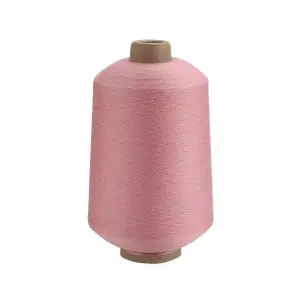At room temperature, the hot melt wire is woven with other fibers into a fabric, and then pressure is applied to the fabric under dry heat or wet heat. When the temperature is higher than the melting point of the hot melt wire, the hot melt wire gradually melts. At this temperature, other conventional fibers remain unchanged and are bonded together by the hot melt wire. Therefore, hot melt wire can replace chemical adhesives such as glue, avoid the pollution of volatiles and powder layers, and is environmentally friendly and non-toxic; at the same time, it saves process flow and reduces downstream production costs.
At present, hot melt wire is widely used in outdoor sports shoe uppers, casual shoe uppers, sofa fabrics, curtains and window screens, carbon fiber cloth shaping, chenille yarn, bondi line, suit lining, lace and glove lock yarn, etc. It is a high-tech product with huge market prospects.
⑴ Good wear resistance. The wear resistance is second only to nylon, which has the best wear resistance, and is better than other natural fibers and synthetic fibers.
⑵ Good thermoplasticity and poor melting resistance. Because the surface of polyester is smooth and the internal molecules are tightly arranged, polyester is the fabric with the best heat resistance among synthetic fiber fabrics. It has thermoplasticity and can be made into pleated skirts, and the pleats are durable. At the same time, the melting resistance of polyester fabrics is poor, and it is easy to form holes when encountering cigarette ash, sparks, etc. Therefore, when wearing, you should try to avoid contact with cigarette butts, sparks, etc.
⑶ Heat-resistant polyester is made by melt spinning, and the formed fibers can be heated and melted again, belonging to thermoplastic fibers. The melting point of polyester is relatively high, while the specific heat capacity and thermal conductivity are relatively small, so the heat resistance and thermal insulation of polyester fibers are higher. It is the best among synthetic fibers.
⑷ Good elasticity. The elasticity is close to wool, and it can almost recover when stretched by 5% to 6%. The wrinkle resistance exceeds other fibers, that is, the fabric does not wrinkle and has good dimensional stability. The elastic modulus is 22 to 141 cN/dtex, which is 2 to 3 times higher than nylon. Polyester fabric has high strength and elastic recovery ability, so it is durable, wrinkle-resistant and iron-free.
⑸ High strength. The strength of short fibers is 2.6-5.7 cN/dtex, and that of high-strength fibers is 5.6-8.0 cN/dtex. Due to its low hygroscopicity, its wet strength is basically the same as its dry strength. Its impact strength is 4 times higher than that of nylon and 20 times higher than that of viscose fibers.
Post time: Sep-28-2024

